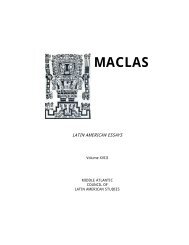latin american essays maclas
latin american essays maclas
latin american essays maclas
Create successful ePaper yourself
Turn your PDF publications into a flip-book with our unique Google optimized e-Paper software.
to authentic personal experience. The novel ends when Gina returns to her<br />
California home, and resolves to review all of the videos, recordings, and<br />
computer files she made of her family, reaching an emotional catharsis that<br />
enables her to go forward in life, as her father would wish, but without leaving<br />
the past behind. Rather, she begins a new life with a brand new memory of her<br />
own.<br />
Memory and Technology<br />
Elías Miguel Muñoz artfully works the question of memory, and its role in<br />
the formation of identity, through the thematic and narrative use of technology.<br />
Throughout the novel, the reader is constantly being exposed to shifting<br />
representations/recordings of reality, always being reminded that what he or she<br />
is reading is, in one way or another, mediated through a medium. This has the<br />
effect of foregrounding the sensation of indirect reality, a performance of life. In<br />
this respect, Muñoz is a writer who refuses to essentialize Latino/a identity. The<br />
instability of perspective he creates is instrumental in his de-essentializing<br />
agenda. Fourteen-year-old Gina Domingo cannot be reduced to the simple label<br />
of Cuban-American teenager. She was born and raised in the United States, to<br />
parents that refuse to discuss their Cuban past. Her mother even refuses to cook<br />
Cuban food. Gina’s identity is therefore a question mark, a quest rather than a<br />
label.<br />
Karen Christian, in her book Show & Tell: Identity as Performance in U.S.<br />
Latina/o Fiction, dedicates her work to questioning the rigid constructs of the<br />
various U.S. Latino identities. She views each identity “. . . as an ongoing process<br />
of invention involving cultural heritage, gender roles, and dynamic interaction<br />
with American dominant culture” (23-24). Moreover, Christian (9) sees that the<br />
younger generation of writers born in Cuba (Elías Miguel Muñoz, Achy Obejas,<br />
Cristina García), “raise issues of social class and cultural identity and operate as<br />
counternarratives to conservative U.S. Cuban discourse. Gay and lesbian voices<br />
further problematize exclusionary views of U.S. Cuban and Latino/a identity by<br />
challenging culturally coded gender constructs.” Within the theoretical framework<br />
of socially constructed identities, Brand New Memory is an excellent example of<br />
the fluid and multi-layered process of identity formation. Muñoz and his<br />
contemporaries come forward with a deliberate ambiguity about what it means<br />
to be a Cuban-American, or to have any other form of identity. They infuse their<br />
characters with a complexity that allows issues to be seen from various angles, in<br />
various contexts, always in a dynamic, rather than fixed, context. Characters are<br />
often caught in a web of contested memories, unable to see clearly the truth of<br />
their family’s history, and along with it, the core of their own identity. 7<br />
Gina is full of questions about “the Truth” regarding Cuba, her family, and<br />
the U.S. society in which she lives. Her biggest question, of course, is herself.<br />
Who is she, and what is her relationship to her world How does her present life<br />
114




